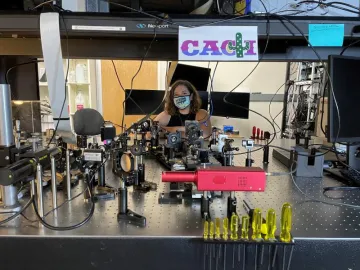Another Wavelength: Lauren Schatz

This month in Another Wavelength, we chat with 6th year Ph.D. Student Lauren Schatz. Lauren is currently mentored by Jared Males at Steward Observatory.
Where are you from?
I am from Simi Valley, California which is about an hour north of LA.

What brought you to study optics?
I studied physics with a concentration in astrophysics at The University of California Santa Cruz for my undergraduate degree. For my senior thesis project I worked at the Center for Adaptive Optics as an alignment assistant for the Shane Telescope adaptive optics system. My mentor at that time, Renate Kupke, is an optical engineer for UCSC and around that time she was beginning a design of a complex spectrograph for the Thirty Meter Telescope. I remember being completely amazed looking at her Zemax model, and realized I had a lot more to learn if I ever wanted to design and build my own instruments. With this goal in mind I decided to study optical science so I could contribute more to the field of astronomy instrumentation.
Who is your hero in science?
My hero in science is my mentor Rosalie McGurk. She was my mentor through my undergraduate studies and inspired me to pursue my graduate education. At the time when I was working on writing my senior thesis, she was writing her PhD thesis. On occasion during our writing sessions she would explain some of her work to me, and I was very impressed and thought she was the most intelligent person I have ever known. At the end of my undergraduate degree I could see the difference in my knowledge and skill set as a scientist compared to her. One of my decisions to go into graduate school was the hope to one day be as brilliant as her. She continues to offer me support and guidance to this day.
Describe your research in 20 words or fewer.
I am researching a new type of wavefront sensor for astronomy adaptive optics systems.
Describe your research in 200 words or fewer.
The Giant Magellan Telescope (GMT) being built at Las Campanas Observatory has seven 8.4m mirrors, that form the 24.5m primary mirror. The GMT has the angular resolution and light collecting power that when combined with an extreme adaptive optics (exAO) system, can resolve earth like planets around M-dwarf stars. To build a first light exAO instrument for the GMT, a new architecture of pyramid wavefront sensor must be developed because current detectors are not large enough or fast enough to provide the spatial sampling and speed for the ELT-exAO wavefront control. Our first concept of an ELT exAO wavefront sensor is a reflective three sided pyramid wavefront sensor (3PWFS). All on-sky systems that use a pyramid wavefront sensor use a four sided pyramid wavefront sensor (4PWFS). The 3PWFS has not been well studied, but has some potential advantages over the 4PWFS, including less sensitivity to read noise and easier manufacturability of the pyramid optic. My project is to fully develop the three sided pyramid wavefront sensor. First, to discern the operation of a 3PWFS in simulation, and then to design and build an experimental exAO testbed to characterize the performance of a real 3PWFS.
Name three neat facts about you.
- Always a glamper, never a camper.
- I acrylic paint in my free time.
- My goal in life is to travel the world, I have been to 18 different countries, half of which I visited during my PhD!
Caption: Lauren Schatz poses in front of the Comprehensive Adaptive Optics and Coronagraphic Test instrument (CACTI) that she designed and built for her Ph.D. research.
